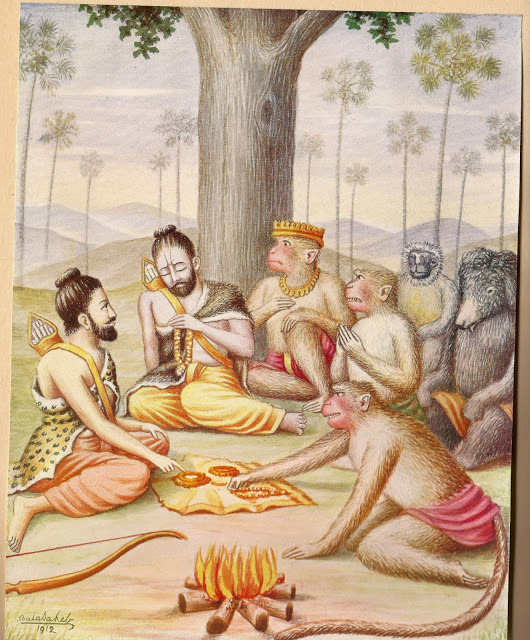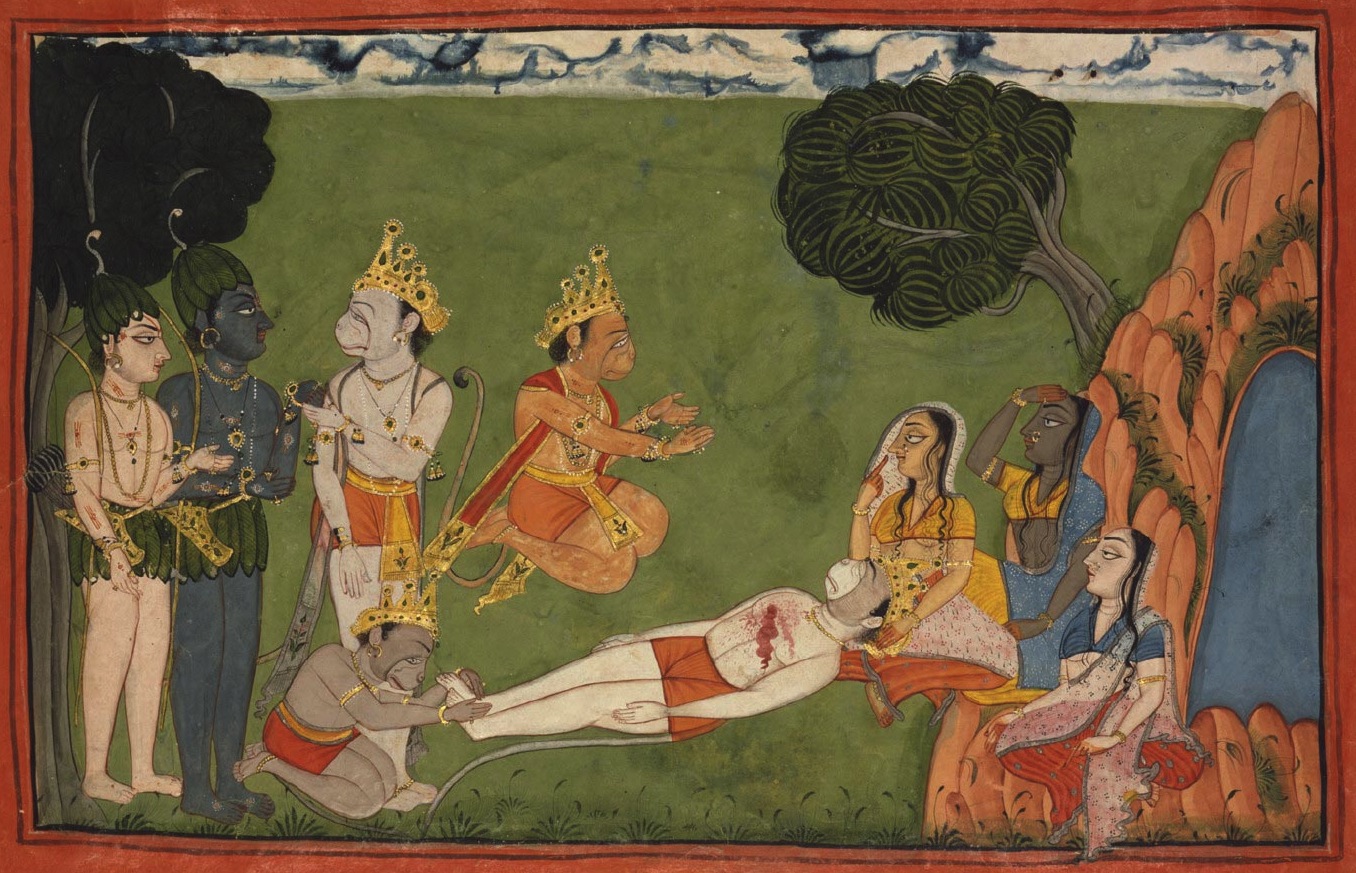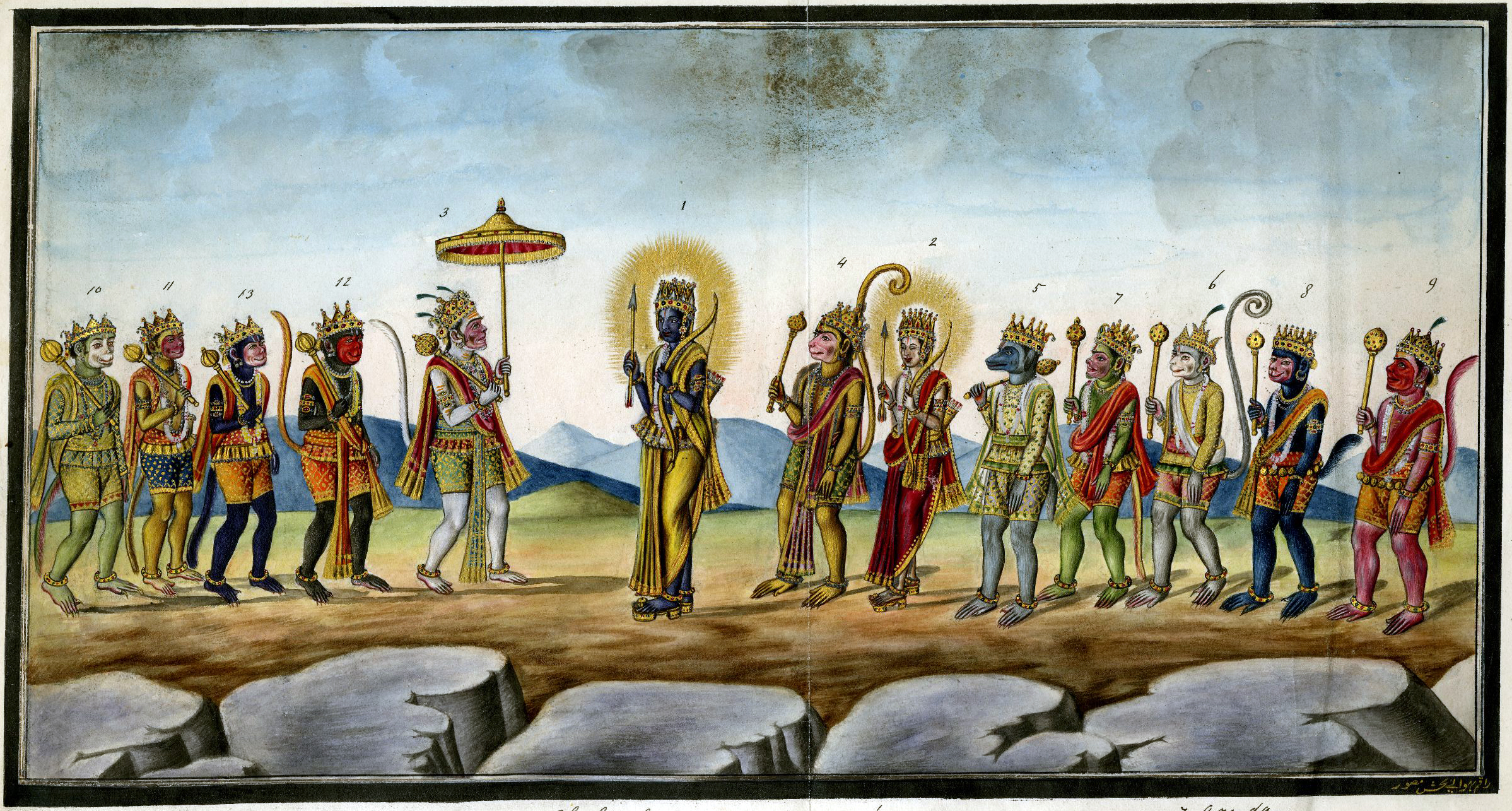|
Kishkindha
Kishkindha (, ) is a kingdom of the vanaras in Hinduism. It is ruled by King Sugriva, the younger brother of Vali, in the Sanskrit epic ''Ramayana''. According to the Hindu epic this was the kingdom that Sugriva ruled with the assistance of his counsellor, Hanuman. Kishkindha is identified with the present location of Hampi, the erstwhile royal capital of Vijayanagara Empire. During the Treta Yuga, the whole region was within the dense Dandaka Forest which was founded by King Danda, son of Ikshvaku, and descendant of Vaivasvata Manu in the Satya Yuga, which extended from the Vindhya range to the South Indian peninsula. Thus, this kingdom was considered that of the vanaras. During the Dvapara Yuga, the Pandava Sahadeva is stated to have visited this kingdom in the epic ''Mahabharata'' during his southern military campaign to collect tribute for Yudhishthira's Rajasuya sacrifice. Literature Ramayana The Ramayana has a book that is based in Kishkindha, known as the Kishkindha ... [...More Info...] [...Related Items...] OR: [Wikipedia] [Google] [Baidu] |
Bali (Ramayana)
Vali () also known as Bali, was a vanara and the king of Kishkindha in the Hindu epic ''Ramayana''. He was the son of Indra, the husband of Tara, the elder brother of Sugriva, and the father of Angada through his wife, Tara. Vali obtained a pendant from his father, Indra, that which allowed him to restore his energy even when nearing death, making him a formidable fighter. He banished his brother Sugriva, who had assumed his throne, believing him to be dead. Sugriva sought the assistance of Rama, an avatar of Vishnu, to intervene in their conflict. During a duel between the brothers, Rama shot Vali in the chest with an arrow. Early life According to the epic, fourteen types of gems or treasures were produced from the churning of the ocean during the time of the Kurma avatar. Among these treasures were various apsaras (divine nymphs), one of whom was Tara. Tara was produced from the churning of the ocean, and Vali, who was assisting his father Indra in the churning, to ... [...More Info...] [...Related Items...] OR: [Wikipedia] [Google] [Baidu] |
Rumā
Rumā () is a vanara also known as Tara and as the queen of Kishkindha mentioned in the epic ''Ramayana''. She is the wife of King Sugrīva, who ruled over the vanara kingdom of Kishkindha. Legend Ruma is mentioned in Book IV (Kishkindha Kanda) of Ramayana. Sugriva fell in love with her. But Ruma's father did not approve. Hence, Sugriva with the help of Hanuman, abducted Ruma and they married each other. Ruma was taken away from Sugriva by Vāli following the strife of two royal Vānara brothers. Later, the fact of Rumā being withheld by Vāli became the primary justification for Rama Rama (; , , ) is a major deity in Hinduism. He is worshipped as the seventh and one of the most popular avatars of Vishnu. In Rama-centric Hindu traditions, he is considered the Supreme Being. Also considered as the ideal man (''maryāda' ...'s slaying Vāli and helping Sugrīva to become the sovereign of Kishkindha. When accused by Vāli of lowly, treacherous, and unexpected a ... [...More Info...] [...Related Items...] OR: [Wikipedia] [Google] [Baidu] |
Sugriva
Sugriva (, ), is a character In the ancient Hindu epic Ramayana. He is the younger brother of Vali (Ramayana), Vali, whom he succeeded as ruler of the vanara kingdom of Kishkindha. He is a son of Surya, the Hindu deity of the sun. As the king of the vanaras, Sugriva aided Rama in his quest to liberate his wife Sita from captivity at the hands of the rakshasa king Ravana. Nomenclature He is also known as , , , , , Creole language, Creole: Soogrim, , , , Sugreeva or Sugreev. Malayalam:Sugreevan. Legend The story of Sugriva is part of Ramayana and in an abbreviated version, is also present in the Mahabharata. The king of Kishkindha, Vrikshraja, was a divine creature born from Brahma's tilaka. He had the body of a human and face and tail of a monkey. He was instructed to roam the forests and kill demons. One day, Vriksharaja entered an enchanted pond, and was transformed into a beautiful lady, attracting the attention of both Indra and Surya. Soon after, they each sired Vali ... [...More Info...] [...Related Items...] OR: [Wikipedia] [Google] [Baidu] |
Tara (Ramayana)
In the Hindu epic ''Ramayana'', Tara (, , ) is the Queen of Kishkindha and the wife of the vanara (monkey) King Vali (Ramayana), Vali. After being widowed, she becomes the Queen of Sugriva, Vali's younger brother. Tara is described as the daughter of the vanara physician Sushena in the ''Ramayana'', and in later sources, as an ''apsara'' (celestial nymph) who rises from the Samudra manthan, churning of the milky ocean. She marries Vali and bears him a son named Angada. After Vali is presumed dead in a battle with a demon, his brother Sugriva becomes king and appropriates Tara; however, Vali returns and regains Tara and exiles his brother, accusing him of treachery. When Sugriva challenges Vali to a duel, Tara wisely advises Vali not to accept because of the former's alliance with Rama—the hero of the ''Ramayana'' and an avatar of the god Vishnu—but Vali does not heed her, and dies from Rama's arrow, shot at the behest of Sugriva. The ''Ramayana'' and its later adaptations e ... [...More Info...] [...Related Items...] OR: [Wikipedia] [Google] [Baidu] |
Hanuman
Hanuman (; , ), also known as Maruti, Bajrangabali, and Anjaneya, is a deity in Hinduism, revered as a divine ''vanara'', and a devoted companion of the deity Rama. Central to the ''Ramayana'', Hanuman is celebrated for his unwavering devotion to Rama and is considered a '' chiranjivi''. He is traditionally believed to be the spiritual offspring of the wind deity Vayu, who is said to have played a significant role in his birth. In Shaiva tradition, he is regarded to be an incarnation of Shiva, while in most of the Vaishnava traditions he is the son and incarnation of Vayu. His tales are recounted not only in the ''Ramayana'' but also in the '' Mahabharata'' and various ''Puranas''. Devotional practices centered around Hanuman were not prominent in these texts or in early archaeological evidence. His theological significance and the cultivation of a devoted following emerged roughly a millennium after the ''Ramayana'' was composed, during the second millennium CE.Paula Richman ... [...More Info...] [...Related Items...] OR: [Wikipedia] [Google] [Baidu] |
Vanaras
In Hinduism, Vanara () are either monkeys, apes, or a race of forest-dwelling people. In the epic the ''Ramayana'', the Vanaras help Rama defeat Ravana. They are generally depicted as humanoid apes, or human-like beings. Etymology There are three main theories about the etymology of the word "Vanara": * Aiyanar suggests that ''vanara'' means "monkey" derived from the word ''vana'' ("forest"), Literally meaning "belonging to the forest" Monier-Williams says it is probably derived from ''vanar'' (lit. "wandering in the forest") and means "forest-animal" or monkey. * Devdutt Pattanaik suggests that it derives from the words ''vana'' ("forest"), and ''nara'' ("man"), thus meaning "forest man" and suggests that they may not be monkeys, which is the general meaning. * It may be derived from the words ''vav'' and ''nara'', meaning "is it a man?" (meaning "monkey") or "perhaps he is man". Identification Although the word Vanara has come to mean "monkey" over the years and th ... [...More Info...] [...Related Items...] OR: [Wikipedia] [Google] [Baidu] |
Vindhya
The Vindhya Range (also known as Vindhyachal) () is a complex, discontinuous chain of mountain ridges, hill ranges, highlands and plateau escarpments in west-central India. Technically, the Vindhyas do not form a single mountain range in the geological sense. The exact extent of the Vindhyas is loosely defined, and historically, the term covered a number of distinct hill systems in central India, including the one that is now known as the Satpura Range. Today, the term principally refers to the escarpment and its hilly extensions that runs north of and roughly parallel to the Narmada River in Madhya Pradesh. Depending on the definition, the range extends up to Gujarat in the west, Uttar Pradesh and Bihar in the north, and Chhattisgarh in the east. The average elevation of the Vindhyas is also dependent on different sources. The word Vindhya is derived from the Sanskrit word ''vaindh'' (to obstruct) and is in reference to a mythological story. The Vindhya range is also known ... [...More Info...] [...Related Items...] OR: [Wikipedia] [Google] [Baidu] |
Tungabhadra
The Tungabhadra River () starts and flows through the state of Karnataka, India, for most of its course, then through Andhra Pradesh where it ultimately joins the Krishna River near Murvakonda. The Tungabhadra derives its name from two streams, the Tunga, about long, and the Bhadra, about long, which rise in the Western Ghats(Sahyadri mountains). The river after the confluence of the two streams in Koodali near Shimoga runs for about till it joins the river Krishna at Sangamaleshwaram in Andhra Pradesh. It runs for in Karnataka, forms the boundary between Karnataka and Andhra Pradesh for and further runs for the next in Andhra Pradesh. The total catchment area of the river is up to its confluence with the Krishna and it is up to Tungabhadra Dam. It is influenced chiefly by the South-West monsoon. It is a perennial river, but the summer flows dwindle to as low as 2.83 to 1.42 cumec (100 to 50 cusec). Etymology A compound of its 2 main tributaries from the Sanskrit wor ... [...More Info...] [...Related Items...] OR: [Wikipedia] [Google] [Baidu] |
Hampi
Hampi or Hampe (), also referred to as the Group of Monuments at Hampi, is a UNESCO World Heritage Site located in the town of Hampi in Vijayanagara district, east-central Karnataka, India. Hampi predates the Vijayanagara Empire; it is mentioned in the ''Ramayana'' and the Puranas of Hinduism as Pampa Devi Tirtha Kshetra. Hampi continues as a religious centre, with the Virupaksha Temple, an active Adi Shankara-linked monastery and various monuments belonging to the old city. Hampi was the capital of the Vijayanagara Empire from 1336 to 1565 (as Vijayanagara), when it was abandoned. It was a fortified city. Chronicles left by Persian and European travellers, particularly the Portuguese, say that Hampi was a prosperous, wealthy and grand city near the Tungabhadra River, with numerous temples, farms and trading markets. Hampi-Vijayanagara is estimated to be the world's second-largest city by 1500, after Beijing, and probably India's richest at that time, attracting traders f ... [...More Info...] [...Related Items...] OR: [Wikipedia] [Google] [Baidu] |
Ramayana
The ''Ramayana'' (; ), also known as ''Valmiki Ramayana'', as traditionally attributed to Valmiki, is a smriti text (also described as a Sanskrit literature, Sanskrit Indian epic poetry, epic) from ancient India, one of the two important epics of Hinduism known as the ''Itihasas'', the other being the ''Mahabharata''. The epic narrates the life of Rama, the seventh ''avatar'' of the Hindu deity Vishnu, who is a prince of Ayodhya (Ramayana), Ayodhya in the kingdom of Kosala. The epic follows Exile of Lord Rama, his fourteen-year exile to the forest urged by his father King Dasharatha, on the request of Rama's stepmother Kaikeyi; his travels across the forests in the Indian subcontinent with his wife Sita and brother Lakshmana; the kidnapping of Sita by Ravana, the king of Lanka, that resulted in bloodbath; and Rama's eventual return to Ayodhya (Ramayana), Ayodhya along with Sita to be crowned as a king amidst jubilation and celebration. Scholarly estimates for the earliest stage ... [...More Info...] [...Related Items...] OR: [Wikipedia] [Google] [Baidu] |








